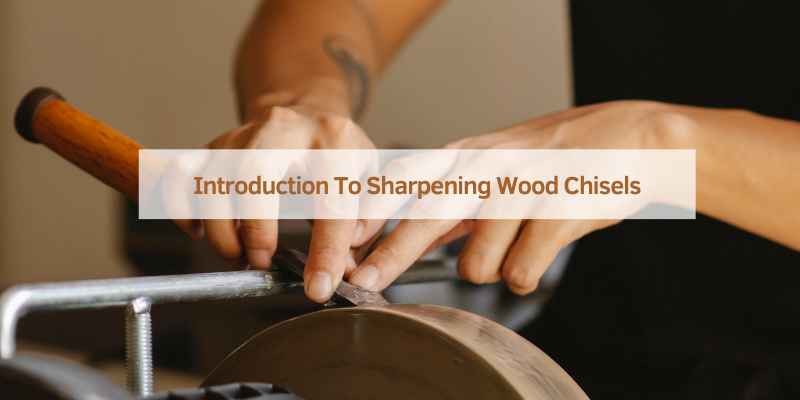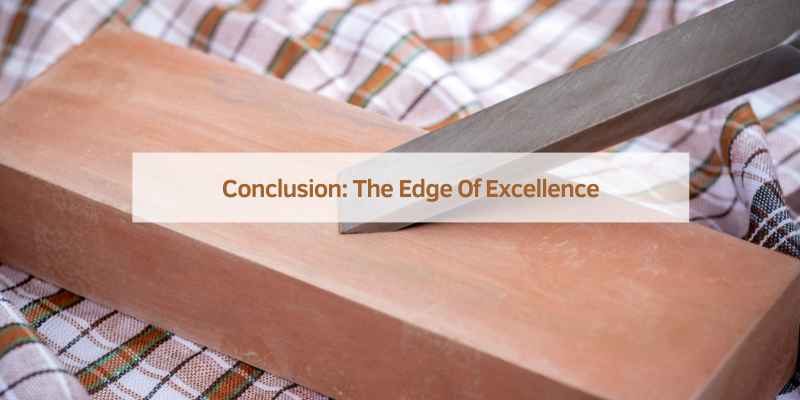To sharpen a wood chisel, aim for a bevel angle of 25 to 30 degrees. This angle provides an ideal balance between sharpness and durability.
When it comes to woodworking, having sharp tools is essential for achieving clean and precise cuts. One of the most important tools in a woodworker’s arsenal is the chisel. To ensure your chisel is at its best, proper sharpening is crucial.
Understanding the correct angle to sharpen a wood chisel is key to maintaining its effectiveness. By following the recommended angle of 25 to 30 degrees, you can achieve a sharp edge that will enhance your woodworking projects. Let’s explore the importance of this angle and how it impacts the performance of your wood chisel.
Introduction To Sharpening Wood Chisels
Sharpening wood chisels is an essential skill for any woodworker. A sharp chisel is crucial for achieving precise cuts and smooth finishes, making woodworking tasks more efficient and enjoyable. Whether you are a seasoned professional or a novice woodworker, understanding the correct angle to sharpen a wood chisel is fundamental to maintaining the tool’s effectiveness.
The Importance Of Sharp Tools
Sharp tools are indispensable for woodworking. A sharp chisel ensures clean and accurate cuts, reduces the risk of splintering, and minimizes the effort required to carve through wood. Regular sharpening not only enhances the performance of the chisel but also prolongs its lifespan, saving you time and money in the long run.
Types Of Wood Chisels And Their Uses
Wood chisels come in various types, each designed for specific woodworking tasks. Beveled edge chisels are versatile and suitable for general purpose work, while paring chisels excel at fine detailing. Mortise chisels are ideal for cutting deep, straight-edged recesses. Understanding the unique characteristics of each type enables woodworkers to choose the most suitable chisel for their projects.

Examining The Anatomy Of A Chisel
Examining the anatomy of a chisel is crucial to understand the proper angle to sharpen a wood chisel. The bevel angle typically ranges between 20 to 30 degrees, and it is essential to maintain consistency while sharpening.
Blade Composition and Structure
The blade of a wood chisel is typically made from high-carbon steel, which offers excellent edge retention and durability. The composition of the blade is crucial in determining its ability to hold a sharp edge, making high-carbon steel an ideal choice for woodworking applications. The blade is usually flat on one side and beveled on the other, with the beveled side being the primary surface for sharpening.
Bevel Edge and Its Role in Sharpening
The bevel edge of a chisel is the angled surface that meets the flat side of the blade. It plays a critical role in the sharpening process, as it determines the cutting angle and edge strength. When sharpening a chisel, the bevel edge is honed to create a sharp cutting edge. The angle of the bevel edge is an essential consideration, as it directly impacts the chisel’s cutting performance and the type of woodworking tasks it is best suited for.
In summary, understanding the composition and structure of the blade, as well as the role of the bevel edge in sharpening, is essential for achieving optimal performance from a wood chisel. By paying attention to these key elements, woodworkers can ensure that their chisels are properly maintained and sharpened for precise and efficient woodworking tasks.
The Art Of Sharpening: Choosing The Right Angle
Achieving the perfect edge on a wood chisel involves selecting the optimal sharpening angle. The ideal angle for sharpening a wood chisel typically ranges between 25 to 30 degrees. This angle ensures a sharp edge that is both durable and effective for woodworking tasks.
Standard Sharpening Angles For Chisels
Factors Influencing The Optimal Sharpening Angle
The art of sharpening a wood chisel lies in selecting the correct angle. The angle at which you sharpen a chisel can significantly impact its performance.
Standard Sharpening Angles For Chisels
Most wood chisels are sharpened at 25 to 30 degrees for general woodworking tasks. For tasks requiring more precision, a higher angle of 30 to 35 degrees is recommended.
Factors Influencing the Optimal Sharpening Angle
1. Wood Type: Hardwoods benefit from a higher sharpening angle compared to softwoods.
2. Chisel Use: For delicate tasks, a lower angle provides better control.
3. Material Removal: Faster material removal is achieved with a lower angle.
4. Edge Durability: A higher angle enhances edge durability.
In conclusion, mastering the art of sharpening a wood chisel involves choosing the right angle based on the task at hand.
Pro Tips For Determining The Perfect Angle
To determine the perfect angle for sharpening a wood chisel, it’s essential to consider the type of wood and the intended use of the chisel. A general guideline is to sharpen the chisel at a 25-degree angle for softwoods and a 30-degree angle for hardwoods.
Experimenting with different angles and testing the chisel on scrap wood can help in finding the ideal angle for the specific task at hand.
The Pencil Trick For Angle Consistency
If you are struggling to maintain a consistent angle while sharpening your wood chisel, the pencil trick can be a game-changer. All you need is a pencil and a piece of paper. Start by drawing a line on the paper using the pencil. Then, hold your chisel against the paper so that the bevel touches the pencil line. Now, tilt the chisel until the entire bevel is in contact with the paper. This will help you determine the angle you need to maintain for sharpening your chisel.
Using A Honing Guide For Precision
If you want to take your sharpening game to the next level, consider investing in a honing guide. A honing guide helps you maintain a consistent angle while sharpening your chisel, ensuring precision and accuracy. Simply attach your chisel to the honing guide and adjust the angle to your desired degree. Then, sharpen your chisel as usual. With a honing guide, you can achieve a razor-sharp edge on your chisel every time.
Sharpening a wood chisel is a skill that takes practice to perfect. But with these pro tips for determining the perfect angle, you’ll be well on your way to achieving a sharp, precise edge on your chisel. Whether you prefer the pencil trick for angle consistency or the precision of a honing guide, you can’t go wrong with either method. So, grab your chisel and get sharpening!
Sharpening Techniques For Wood Chisels
When sharpening a wood chisel, it is important to consider the angle. The optimal angle to sharpen a wood chisel is typically around 25 degrees. This angle provides a good balance between sharpness and durability, allowing for precise and clean cuts in wood.
Manual Sharpening With Whetstones
Sharpen wood chisels with precision using manual whetstone techniques.
Power Sharpening Tools And Attachments
Use power tools for efficient and effective wood chisel sharpening.
Honing For A Razor-sharp Edge
Achieve a razor-sharp edge on your wood chisel by honing it at the correct angle. Discover the optimal angle to sharpen a wood chisel for precise and efficient woodworking results.
The Role Of Honing In The Sharpening Process
Honing is the final step in sharpening a wood chisel and plays a crucial role in achieving a razor-sharp edge. Honing removes any burrs or imperfections left behind by the sharpening process, resulting in a smooth and polished edge. Without honing, your chisel may still be sharp, but it won’t have the same level of precision and control.
Honing Compounds And Leather Strops
To hone your wood chisel, you’ll need honing compounds and a leather strop. Honing compounds are abrasive pastes that help remove any remaining burrs or imperfections from the chisel’s edge. Leather strops are used to apply the honing compound and buff the chisel’s edge to a razor-sharp finish.
When choosing honing compounds, consider the grit size. Coarse grits are best for removing larger burrs and imperfections, while fine grits are ideal for polishing and refining the chisel’s edge. Diamond paste is also an option for honing, as it’s highly abrasive and produces a very sharp edge.
Using Honing Compounds And Leather Strops
To apply honing compounds to your leather strop, simply place a small amount of the compound on the strop and spread it evenly with your finger. Then, hold the chisel at a consistent angle and draw it across the strop, using a light but firm pressure. Repeat this process several times, alternating sides, until the chisel’s edge is polished and razor-sharp.
When honing your wood chisel, it’s important to maintain a consistent angle. The angle you choose will depend on the type of chisel you’re using and the task at hand. However, a good rule of thumb is to start with a 25-degree angle and adjust as needed. Remember to keep your strokes consistent and avoid applying too much pressure, as this can damage your chisel’s edge.
In conclusion, honing is a crucial step in achieving a razor-sharp edge on your wood chisel. By using the right honing compounds and leather strops, and maintaining a consistent angle and pressure, you can ensure your chisel is sharp and precise, allowing you to tackle any woodworking project with ease.
Maintaining The Chisel’s Edge
A sharp wood chisel is an essential tool for any woodworking project, allowing you to make precise and clean cuts. However, over time, the chisel’s edge can become dull, reducing its effectiveness. In this section, we will explore some important techniques for maintaining the chisel’s edge, ensuring optimal performance and longevity.
Routine Touch-ups For Lasting Sharpness
To keep your wood chisel performing at its best, regular touch-ups are necessary. This involves honing the edge to maintain its sharpness. Here are a few steps to follow:
- Start by securing the chisel in a vice or holding it firmly with one hand.
- Using a sharpening stone, hold it flat against the bevel edge of the chisel.
- Moving the stone in a circular or back-and-forth motion, apply gentle pressure to remove any burrs or nicks.
- Continue sharpening until you achieve a smooth, polished edge.
- Remember to periodically check the angle of the bevel and adjust as needed.
Regular touch-ups will not only keep your chisel sharp but also prevent the need for extensive sharpening sessions in the future.
Protecting The Chisel Edge Between Uses
When your woodworking project requires multiple breaks or when you finish for the day, it’s crucial to protect the chisel’s edge from damage or dulling. Here are a few tips:
- Always store your chisels in a dedicated case or rack, keeping them separate from other tools to avoid accidental nicks or dings.
- Consider using blade guards or sheaths to protect the cutting edge during storage or transportation.
- Avoid placing your chisel on a hard surface where it can be easily knocked or damaged.
- Regularly inspect the chisel’s edge for any signs of damage or wear, addressing them promptly to prevent further deterioration.
By taking these simple precautions, you can extend the lifespan of your chisel and ensure it remains sharp and ready for your next woodworking project.
Common Mistakes To Avoid When Sharpening
When sharpening a wood chisel, it’s important to pay attention to the sharpening angle. The ideal angle for sharpening a wood chisel is typically around 25 degrees. Avoid common mistakes such as using the wrong angle, as it can affect the chisel’s performance and durability.
When it comes to sharpening a wood chisel, there are a few common mistakes that many beginners make. These mistakes can affect the performance and lifespan of the chisel, so it’s important to be aware of them and avoid them. In this section, we will discuss two of the most common mistakes: overheating the blade and neglecting the chisel’s back flatness.
Overheating The Blade
One of the most common mistakes people make when sharpening a wood chisel is overheating the blade. This usually happens when using power tools such as grinders or electric sharpeners. When the blade gets too hot, it can lose its temper, resulting in a softer edge that dulls quickly.
To avoid this mistake, it’s important to take breaks while sharpening and let the blade cool down. Additionally, using a slow speed and applying gentle pressure can help prevent overheating. Remember, a sharp chisel is more effective than a hot one!
Neglecting The Chisel’s Back Flatness
Another common mistake is neglecting the chisel’s back flatness. The back of the chisel should be flat and polished to ensure a clean and precise cut. Neglecting this aspect can lead to uneven sharpening and reduced performance.
To avoid this mistake, start by checking the back of the chisel for any irregularities. If you notice any convex or concave areas, it’s important to flatten them using a sharpening stone or sandpaper. By maintaining a flat back, you can achieve a sharper and more accurate cutting edge.
In conclusion, when sharpening a wood chisel, it’s crucial to avoid common mistakes such as overheating the blade and neglecting the chisel’s back flatness. By being mindful of these aspects, you can ensure a sharper and more effective chisel that will enhance your woodworking projects.
Advanced Sharpening Techniques
Discover advanced sharpening techniques for wood chisels, focusing on the optimal angle for sharpening. Understanding the correct angle can enhance the chisel’s performance and precision in woodworking projects. Mastering this technique is key for achieving clean and precise cuts in your woodwork.
When it comes to woodworking, having a sharp chisel is essential for achieving clean and precise cuts. While most woodworkers know the basics of sharpening a chisel, there are advanced techniques that can take your sharpening game to the next level. In this post, we’ll discuss two advanced sharpening techniques: micro-bevels and sharpening splayed or skewed chisels.
Micro-bevels For Enhanced Performance
Micro-bevels are a technique that involves creating a small secondary bevel at the tip of your chisel. This technique is used to enhance the performance of your chisel by increasing its durability and reducing the frequency at which it needs to be sharpened.
To create a micro-bevel, start by sharpening your chisel as you normally would. Once you’ve achieved a sharp edge, raise the angle slightly and sharpen the tip of the chisel. This will create a small secondary bevel that will help protect the primary bevel from damage during use.
Sharpening Splayed Or Skewed Chisels
Splayed or skewed chisels are chisels that have a bevel that is not perpendicular to the sides of the chisel. These chisels are often used for specific woodworking tasks, such as creating angled joints or dovetails. However, sharpening these chisels can be a bit tricky.
To sharpen a splayed or skewed chisel, start by determining the angle of the bevel. Once you know the angle, sharpen the chisel as you normally would, but make sure to maintain the angle of the bevel throughout the sharpening process. It may take some practice to get the hang of sharpening splayed or skewed chisels, but with a bit of patience and persistence, you’ll be able to achieve a sharp edge on these specialized chisels.
Conclusion: The Edge Of Excellence
Achieving excellence in woodworking hinges on mastering the art of chisel sharpening. The key is to sharpen the wood chisel at a precise angle to ensure optimal cutting performance and efficiency. Consistent practice and attention to detail will give your projects the edge of excellence.
Summarizing The Sharpening Journey
Sharpening a wood chisel is crucial for precise woodworking.
Consistent angle maintenance ensures optimal cutting performance.
Correct angle selection depends on the chisel type and purpose.
Regular maintenance prolongs the chisel’s lifespan.
Proper sharpening technique is key to achieving fine woodworking results.
Continued Learning And Practice
Practice sharpening to master the skill over time.
Experiment with different angles to find the best fit.
Seek guidance from experienced woodworkers for valuable tips.
Continuous practice hones sharpening proficiency.
Sharpening is an ongoing process for woodworking success.

Frequently Asked Questions
Faq 1: What Is The Ideal Angle To Sharpen A Wood Chisel?
The ideal angle to sharpen a wood chisel is typically between 25 to 30 degrees. This angle allows for a sharp edge that can easily cut through wood fibers without causing excessive damage. A steeper angle may result in a more durable edge, but it may also be prone to chipping.
Conversely, a shallower angle may provide a finer edge, but it may not hold up well to heavy use.
Faq 2: How Often Should I Sharpen My Wood Chisel?
The frequency of sharpening your wood chisel depends on how often you use it. As a general guideline, it is recommended to sharpen your chisel every few weeks or whenever you notice a decrease in cutting efficiency. Regular maintenance and honing will help maintain the chisel’s performance and prolong its lifespan.
Faq 3: Can I Use A Bench Grinder To Sharpen My Wood Chisel?
While a bench grinder can be used to sharpen a wood chisel, caution must be exercised to prevent overheating and damaging the blade. It is recommended to use a slow-speed grinder or a sharpening system specifically designed for chisels. This ensures better control and reduces the risk of overheating, which can affect the temper of the chisel’s blade.
Faq 4: What Are The Essential Tools Needed For Sharpening A Wood Chisel?
To sharpen a wood chisel, you will need a few essential tools. These include a sharpening stone or whetstone, honing guide, and a strop or leather strop. Additionally, you may find a honing compound, a marker or pencil for marking the bevel, and a flat surface to work on helpful in achieving optimal results.
Conclusion
Understanding the correct angle to sharpen a wood chisel is crucial for achieving precise and efficient results in woodworking. By following the recommended angle and using the right sharpening techniques, you can enhance the durability and performance of your wood chisel, ultimately improving your woodworking experience.


